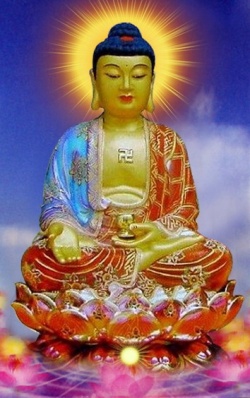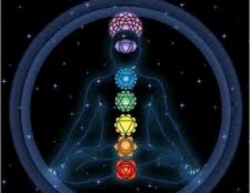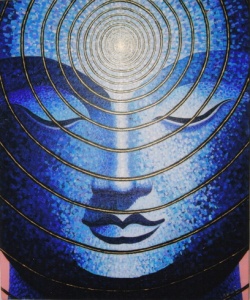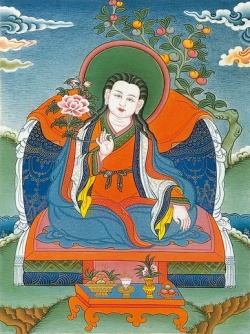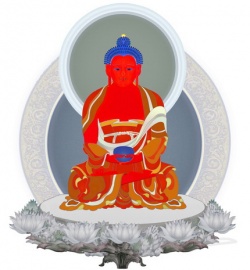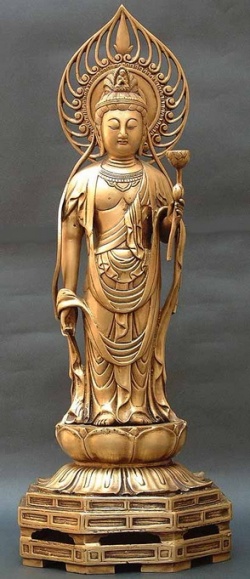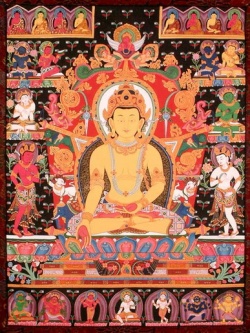Difference between revisions of "The Tantric Approach"
| Line 23: | Line 23: | ||
The [[Tantric]] [[Wikipedia:Magician(paranormal)|magician]] uses this [[magic]] to increase his or her [[energy]], [[compassion]], [[understanding]] of the [[Dharma]], and so on. [[Amitabha]], the red [[Buddha]] of [[love]], is naturally the {{Wiki|patron}} of [[rites]] of fascination. Rather than practise these to compel a lover to return, the [[yogin]] or [[yogini]] [[causes]] all [[beings]] to fall in [[love]] with the [[Dharma]]. [[Vairocana]] - [[serene]] in the centre of the [[mandala]] - holds sway over [[rites]] of pacification.3 Again, it is the waves of negative [[emotion]] that his [[rites]] pacify. Amoghasiddhi's all-performing [[wisdom]] allows him to be associated with [[success]] in all [[forms]] of [[magic]], to gain the [[supreme siddhi]], or [[magic]] power, of gaining [[Enlightenment]]. The [[Tantric]] {{Wiki|adept}} is even referred to as a [[siddha]] - one who has attained [[magic]] [[powers]]. These [[powers]] can be supernormal (such as levitation, {{Wiki|telepathy}}, etc.) or involve the development of [[spiritual]] qualities. There is a well-known group of eighty-four (sometimes eighty-five) [[mahasiddhas]] (great [[Tantric]] {{Wiki|adepts}}), who nourished in [[India]] from the eighth to twelfth centuries. They [[form]] the beginning of a chain of [[human]] [[Tantric]] practitioners who have carried on the major [[forms]] of [[Tantric practice]] to this day. The [[lives]] of these eighty-four [[Indian]] men and women abound in episodes that demonstrate the [[magical]] power over natural [[phenomena]] that they have gained through [[Tantric practice]]. | The [[Tantric]] [[Wikipedia:Magician(paranormal)|magician]] uses this [[magic]] to increase his or her [[energy]], [[compassion]], [[understanding]] of the [[Dharma]], and so on. [[Amitabha]], the red [[Buddha]] of [[love]], is naturally the {{Wiki|patron}} of [[rites]] of fascination. Rather than practise these to compel a lover to return, the [[yogin]] or [[yogini]] [[causes]] all [[beings]] to fall in [[love]] with the [[Dharma]]. [[Vairocana]] - [[serene]] in the centre of the [[mandala]] - holds sway over [[rites]] of pacification.3 Again, it is the waves of negative [[emotion]] that his [[rites]] pacify. Amoghasiddhi's all-performing [[wisdom]] allows him to be associated with [[success]] in all [[forms]] of [[magic]], to gain the [[supreme siddhi]], or [[magic]] power, of gaining [[Enlightenment]]. The [[Tantric]] {{Wiki|adept}} is even referred to as a [[siddha]] - one who has attained [[magic]] [[powers]]. These [[powers]] can be supernormal (such as levitation, {{Wiki|telepathy}}, etc.) or involve the development of [[spiritual]] qualities. There is a well-known group of eighty-four (sometimes eighty-five) [[mahasiddhas]] (great [[Tantric]] {{Wiki|adepts}}), who nourished in [[India]] from the eighth to twelfth centuries. They [[form]] the beginning of a chain of [[human]] [[Tantric]] practitioners who have carried on the major [[forms]] of [[Tantric practice]] to this day. The [[lives]] of these eighty-four [[Indian]] men and women abound in episodes that demonstrate the [[magical]] power over natural [[phenomena]] that they have gained through [[Tantric practice]]. | ||
| − | [[Tantra]] addresses the whole [[person]] As we have seen, [[Tantra]] is {{Wiki|pragmatic}} and down to [[earth]]. It will not leave any aspect of us untransformed. [[Buddhism]] distinguishes three aspects to a [[human being]] - | + | [[Tantra]] addresses the whole [[person]] As we have seen, [[Tantra]] is {{Wiki|pragmatic}} and down to [[earth]]. It will not leave any aspect of us untransformed. [[Buddhism]] distinguishes three aspects to a [[human being]] - body, speech, and mind, and a [[Tantric practice]] will usually involve all of them. The [[body]] may be involved through making [[prostrations]], turning [[prayer wheels]], circumambulating, making [[physical]] [[offerings]], or [[mudra]]. We have seen how [[Buddhas]] and [[Bodhisattvas]] are depicted making [[mudras]] that express their [[spiritual]] qualities. The [[Tantric]] [[practitioner]] also employs [[mudra]], using the [[body]] as a support for [[meditation]] by thus involving it. For the [[Vajrayana]], a [[spiritual]] [[experience]] is not complete until it has percolated right through to your fingertips. [[Speech]] is involved through recitation, especially of [[mantras]]. The [[mind]] is given complex [[symbolic]] [[visualizations]] to dwell on. In this way the [[Vajrayana]] weaves patterns of practice that involve your total being. 4 [[Tantra]] sees the [[world]] in terms of [[energy]] If you practise the [[Dharma]] in an orderly fashion, you only take up the practice of the [[Vajrayana]] once you have deep [[experience]] of the [[Mahayana]]. |
[[Maha]] means great (so the [[Mahayana]] is the 'great way' to [[Enlightenment]]). However, [[maha]] also often implies 'conjoined with [[Sunyata]]' (see Glossary). For instance mahakarund, the '[[great compassion]]' of the [[Bodhisattva]], is the [[compassion]] that has arisen out of the [[experience]] of [[sunyata]]. So if you follow the [[path]] of regular steps, as it is called, you only embark on [[Tantra]] once you have passed through the flames of [[Sunyata]] in [[Mahayana]] practice. If you have passed through those flames, and transmuted your [[consciousness]] within them, how do you see the [[world]]? If the substantial [[objects]] and [[people]], the discrete, separate selfhoods, have all been dissolved into {{Wiki|processes}}, ever changing, then what is left? What you [[experience]] are patterns of [[energy]], some more congealed, others more freeflowing. [[Tantric practice]], then, is very much concerned with [[energy]]. In particular, [[Tantra]] works with very {{Wiki|subtle}} levels of [[energy]] within the [[human body]]. In some advanced [[Tantric practices]] you [[visualize]] a whole [[subtle energy]] system, composed of channels, [[winds]], and drops ([[Sanskrit]] [[nadi]], [[prana]], and bindu).4 Through directing the [[subtle energy]] flow through [[visualization]], the energies are led into the [[central channel]] ([[Sanskrit]] [[avadhuti]], [[Tibetan]] tsa uma), located in front of the spine. (Here, though, we are working on the level of the {{Wiki|subtle}}, [[visualized]] [[body]]; relating it to the spine enables us to [[visualize]] it in the right location, it does not imply that the [[central channel]] is on the same [[plane of reality]] as the [[physical]] spine.) Once the {{Wiki|subtle}} energies, or [[winds]], have entered one or another of the [[cakras]], the [[subtle energy]] centres of the [[central channel]], a particularly deep level of [[concentration]] is attained. Through [[meditation]] on [[Sunyata]] while in this state, the [[Tantra]] claims you can gain [[Enlightenment]] very quickly. It is the use of [[meditation]] on this [[subtle energy]] system, not found in the other [[yanas]], which it is claimed can make the [[Vajrayana]] a 'short [[path]]' to [[Enlightenment]]. In this state of deep [[concentration]], when the [[winds]] dissolve in the [[central channel]], one [[experiences]] the [[mental phenomena]] that happen at the [[time]] of [[death]]. If the [[Tantric]] [[yogin]] or [[yogini]] has already [[experienced]] these [[phenomena]] in [[meditation]], it enables them to go through the actual [[death]] [[experience]], when the [[time]] comes, with [[awareness]] and control. In this way they can either transcend the [[endless]] round of [[birth]] and [[death]] altogether, or select a place and [[form]] of [[rebirth]] in which they can be most helpful to other [[beings]]. | [[Maha]] means great (so the [[Mahayana]] is the 'great way' to [[Enlightenment]]). However, [[maha]] also often implies 'conjoined with [[Sunyata]]' (see Glossary). For instance mahakarund, the '[[great compassion]]' of the [[Bodhisattva]], is the [[compassion]] that has arisen out of the [[experience]] of [[sunyata]]. So if you follow the [[path]] of regular steps, as it is called, you only embark on [[Tantra]] once you have passed through the flames of [[Sunyata]] in [[Mahayana]] practice. If you have passed through those flames, and transmuted your [[consciousness]] within them, how do you see the [[world]]? If the substantial [[objects]] and [[people]], the discrete, separate selfhoods, have all been dissolved into {{Wiki|processes}}, ever changing, then what is left? What you [[experience]] are patterns of [[energy]], some more congealed, others more freeflowing. [[Tantric practice]], then, is very much concerned with [[energy]]. In particular, [[Tantra]] works with very {{Wiki|subtle}} levels of [[energy]] within the [[human body]]. In some advanced [[Tantric practices]] you [[visualize]] a whole [[subtle energy]] system, composed of channels, [[winds]], and drops ([[Sanskrit]] [[nadi]], [[prana]], and bindu).4 Through directing the [[subtle energy]] flow through [[visualization]], the energies are led into the [[central channel]] ([[Sanskrit]] [[avadhuti]], [[Tibetan]] tsa uma), located in front of the spine. (Here, though, we are working on the level of the {{Wiki|subtle}}, [[visualized]] [[body]]; relating it to the spine enables us to [[visualize]] it in the right location, it does not imply that the [[central channel]] is on the same [[plane of reality]] as the [[physical]] spine.) Once the {{Wiki|subtle}} energies, or [[winds]], have entered one or another of the [[cakras]], the [[subtle energy]] centres of the [[central channel]], a particularly deep level of [[concentration]] is attained. Through [[meditation]] on [[Sunyata]] while in this state, the [[Tantra]] claims you can gain [[Enlightenment]] very quickly. It is the use of [[meditation]] on this [[subtle energy]] system, not found in the other [[yanas]], which it is claimed can make the [[Vajrayana]] a 'short [[path]]' to [[Enlightenment]]. In this state of deep [[concentration]], when the [[winds]] dissolve in the [[central channel]], one [[experiences]] the [[mental phenomena]] that happen at the [[time]] of [[death]]. If the [[Tantric]] [[yogin]] or [[yogini]] has already [[experienced]] these [[phenomena]] in [[meditation]], it enables them to go through the actual [[death]] [[experience]], when the [[time]] comes, with [[awareness]] and control. In this way they can either transcend the [[endless]] round of [[birth]] and [[death]] altogether, or select a place and [[form]] of [[rebirth]] in which they can be most helpful to other [[beings]]. | ||
Latest revision as of 12:16, 25 January 2014
A peaceful and saintly Tibetan monk sits in his monastery. His room is virtually dark It is hard to discern anything. As our eyes become accustomed to the dim light they take in a scene that is at odds with the serene expression of the monk. In lurid, gory detail, monstrous shapes brandishing terrifying weapons stare menacingly from the dark paintings on the walls. Hung from the ceiling are the carcasses of wild beasts. In the jumbled Sanskrit of the mantras the lama is reciting we make out the words 'Kill! Kill! Trample, destroy!' A young woman carries her purchases through a new shopping mall. She sees the giant store as a beautiful mandala palace. The checkout girls and shoppers are gods and goddesses. She imagines that the background music is the mantra of her chosen deity. She treats her desire for a chocolate bar as though it were the wisdom of a Buddha. A wild-eyed man stands in a cremation ground. He is dressed with ornaments made of human bone. He produces a musical instrument from the folds of his clothing. It is a human thighbone. He stares about him. In his imagination he is conducting his own funeral.
His corpse has been transmuted into an ocean of nectar, upon which sentient beings are invited to feast. A celibate nun imagines herself locked in sexual union with a young lover. During the embrace she offers him a cup fashioned from a human skull, and pours the red liquid it contains into his mouth. She tells her spiritual teacher that this fantasy is taking on a tremendous reality for her. The guru is pleased with her progress. I have chosen these examples as stark demonstrations of the very different world we are entering in this book. The two previous books in this series, A Guide to the Buddhas and A Guide to the Bodhisattvas, introduced readers to the various Buddhas and Bodhisattvas described in the Buddhist sutras. They are thus part of the world of the Mahayana. Their descriptions are illuminated by a Mahayana world-view. Most of them are calm and serene, exuding the great love (Sanskrit mahamaitri) and great compassion (Sanskrit mahakaruna) which conjoined with transcendental wisdom constitute the perfect expression of Enlightenment in the Mahayana sutras. The one glaring exception (literally) was the wrathful form of Vajrapani.
He was an omen of what is to come in this final book of the series. The Hlnayana and Mahayana schools are collectively designated the Sutrayana, because they are based on the sutras. The sutras are carefully preserved records of the Buddha's oral teachings, or the teachings of advanced disciples that were approved by the Buddha. The Pali suttas of the Hinayana give factual accounts of the Buddha's life and teaching. We see him seated in jungle clearings or calmly walking the dusty Indian roads. Everywhere he goes, he teaches. His teaching is pragmatic, avoiding all metaphysical speculation. In essence it is all related to suffering, and the practical methods for overcoming it. There are miraculous events, such as the 'twin miracle', where the Buddha is represented rising into the air and producing fire and water from his body simultaneously. Most of the time, though, we are in the everyday world, being taught how to work patiently with our mental states to overcome craving, hatred, and ignorance. That done, we can see life as it really is, and attain the deathless state. Reading the Mahayana sutras we find ourselves on the very summit of existence. The Buddha sits on a Vulture's Peak1 that no Indian traveller would recognize. He is Sakyamuni transfigured, emanating light from his body to call Buddhas to visit him from distant universes.
Dimensions expand and contract. Miraculous beings appear from nowhere in the midst of the vast assembly of Bodhisattvas and arhats who are listening to the Buddha's discourse. The medium of these sutras is the message. An infinite number of universes are embraced by the Buddha's compassion, just as his radiance lights up endless galaxies. The teaching is subtle, mysterious, ungraspable. The intellect is confounded by Perfect Wisdom, which defies the laws of logic, just as the Buddha's display of psychic powers transcends the laws of science. Our hearts expand to embrace all beings, just as the Bodhisattva appears everywhere, in all realms, in his tireless work of salvation. The Mahayana sutras appeal to the imagination. Their cosmic drama lifts us out of our mundane world and everyday selves into the archetypal realm. We are shown a vision of the Ultimate, beyond duality, beyond time and space. Any approach to human development can become one-sided or stagnant. After a while, the Hinayana approach tended to fall into dogmatic literalism, and to spend much time in academic classification of negative and positive psychological states, rather than getting down to the job of transforming one into the other. The Mahayana's rich imagination overcame any tendency to dogmatism and narrowness. Its radical reduction of all concepts to sunyata put the academic categories of the Hinayana in their proper perspective. However, the Mahayana also fell prey at times to certain dangers. Rejoicing in the subtle sharpness of its dialectic, entranced by its archetypal glory, the feet of some Mahayana followers began to lose touch with the ground of everyday reality. The attempt to counterbalance this tendency of the Mahayana finds expression in the Vajrayana ('way of the diamond thunderbolt'). The Vajrayana is synonymous with the Buddhist Tantric schools.
The Hinayana, at its worst, had kept its feet on the ground of direct experience, but lost touch with its spiritual imagination. The Mahayana occasionally lost its head in the golden clouds of the archetypal. The Vajrayana, in a radical stroke of genius, aimed to see the archetypal in the everyday, the exalted goal of nirvana in the mud and dust of samsara. It fused Hinayana pragmatism and Mahayana imagination into the vajra of the Tantric approach to life. (I am not suggesting that these waves of counterbalancing reactions between schools were conscious. They were probably largely intuitive.) By and large, the followers of Tantra did not deny the Mahayana approach. They saw it simply as a foundation on which to lay down their unique approach to Enlightenment. The Vajrayana teachings find their authority not in the sutras but in the Buddhist tantras. Sutra literally means thread. Each sutra contains a teaching by the Buddha that has a logical thread or continuity to it. Tantra, however, means something woven. This suggests an added dimension. The tantras are not usually logically connected pieces of teaching.
It is as though the threads of the sutras have been woven into a tapestry, in which the continuity of any individual thread may be lost from sight. The tantras are all attributed to Sakyamuni - usually under his Tantric name of Buddha Vajradhara - and it is claimed that their teachings were bestowed by him in secret. When you attempt to relate to the everyday through the archetypal, or to manipulate spiritual forces through natural ones, what you are involved in is magic. The contents of the tantras are a witch's brew of magical spells and rituals, yogic instructions and profound teachings, often in jumbled fragments which make them unintelligible to the uninitiated. They are like the grimoires of an Enlightened wizard - who practises a transcendental magic that cannot be said to be either black or white. The fact that Tantric texts often make little sense to a reader unprovided with the keys for deciphering them underlines the central importance of the guru in the Tantra. As we shall see in Chapter Four, the guru occupies the centre of the mandala of Tantric practice. It is through him that realization dawns. In fact, traditionally one cannot even step onto the Tantric path without the guru, for it is he who opens the gates to each stage of the path by bestowing initiation. Tantric practices and their associated initiations are divided into different levels. Most Tibetan schools recognize four main ones: kriya (action), carya (performance), yoga (union), and anuttarayoga (supreme union).2 The first three are known collectively as the Lower Tantras; their practice involves more external rituals.
The anuttarayoga, or Highest Tantra, needs no external ritual at all. At each level of Tantra one is introduced to a different degree of under- standing, and one's relationship to the Buddha, Bodhisattva, or other Tantric deity around which the ritual centres changes. The higher the tantra, the more intimate the relationship - the more totally identified you become with the state of Buddhahood. Highest Tantra is itself divided by most Tibetan schools into the two stages of kyerim, the generation stage, and dzokrim, the completion stage. In the generation stage you work to identify yourself as completely as possible with an aspect of Enlightenment through visualization. This serves as preparation for the completion stage, which is concerned with the manipulation of subtle psychophysical energies in order to bring about a profound transformation of consciousness. However, rather than become involved in a lengthy analysis of the technicalities of the Tantric tradition, we shall concentrate on the underlying principles of Tantra. If we can set these cornerstones in place we shall understand the essentials. Then we shall be able to approach the Tantra with confidence, without being bewildered by the extraordinary luxuriance of its forms. To do this, we are going to look in turn at seven characteristics of the Vajrayana. 1 Tantra is concerned with direct experience We saw that Tantra developed partly in response to the Mahayana tendency to lose touch with the everyday world. Tantra is pragmatic. It has a critical 'how does it actually help?' approach to spiritual teachings.
However fine your ideas, however beautiful your imaginative fantasies, if some aspect of Buddhism makes no difference to your actual experience, the Tantra is not interested. It tries to make everything directly accessible and usable. If you have not had a particular spiritual experience, it asks you to find whatever in your personal experience corresponds with it. For example, it is as though the Tantra says, 'You say you take Refuge in the Buddha. But Sakyamuni Buddha died 2,500 years ago. If you were very highly spiritually developed you might still feel his spiritual influence, but what if you're not? You need direct contact to inspire you, not just books. So if you've missed out on Sakyamuni, who in your own experience comes closest to being Enlightened? Who are you in actual contact with who is most like a Buddha?... Your guru? All right then, as far as you are concerned your guru is the Buddha, your Buddha Refuge.' The Tantra does the same with the other refuges, as we shall see in Chapters Five and Six. Tantra, then, aims to enable you to experience the truths of Buddhism directly. It is not interested in theories and ideas per se. Like Zen, it asks to be shown, here and now in this room, non-duality, Sunyata, compassion, and all those other fine-sounding ideas. A Buddhist teacher once produced an aphorism 'work is the Tantric guru'. If you are building a wall, it is either there at the end of the day or it is not. Your ideas about what lovely walls you could build count for nothing. Hard work gives you objective feedback on your capacity to mobilize your energy and get things done.
It demands a great deal of you. You really have to give yourself to it. All these things are true also of the Tantric guru, and the Tantric approach. It demands hard work and dedication to actualize the Tantric path. Tantra is often said to be a quick path to Enlightenment. People become excited by this, but in the spiritual life you never obtain something for nothing. Unless your karma is exceptionally good, before you can truly enter upon the Vajrayana you need long preparation in the Sutrayana. In addition, the practice of Tantra requires great effort, energy, and determination. As another aphorism says, 'The Tantra is quick and easy, if you work long enough and hard enough!' 2 Tantra works with symbols and magic If the Tantra is to be a quick path, it has to effect a radical transformation of your whole being, both conscious and unconscious. The Sutrayana addresses itself to both head and heart, but not so directly to the unconscious. If you want to involve that level of yourself in the quest for Enlightenment, you have to communicate with it and win over its energies. What language can you use to do so? We could compare the human psyche to a great city like London or Rome. On the surface it is full of the life and concerns of the twenty-first century, but those banks and office blocks have been erected over the rubble of previous buildings. We can dig down through various strata to earlier periods. Now we find a Roman villa, now a pagan temple, now a primitive earthwork fortification. Something similar can be seen in the development of the human psyche. We live our lives as more or less selfconscious, rational beings. Yet the level of consciousness we have reached is the latest stage of a process going back over millennia. As far as we can tell, primitive man had little self-consciousness.
He lived in a twilight, dream-like world, unable fully to differentiate between his inner and outer reality. It is as though, in the unconscious, we carry this racial memory. Our consciousness, too, has 'strata' - some of which are not rational at all. We become aware of them in dreams, and in other situations where archetypal contents well up into the light of consciousness. To communicate with these deeper strata we have to speak their language. That language is the language of myth, symbol, and magic. Magic is the 'technology' that primitive man used to control his world. To transform our primitive depths we cannot give them lectures on impermanence and Sunyata, we have to resort to magic. The Tantra, then, borrowed magical rites from its ethnic context and turned them to its own purposes. We can see this in sadhanas connected with the five Buddha families of the mandala (see Glossary). Aksobhya is associated with the poison of hatred, which he transmutes into wisdom. The Tantra does this by taking magical rituals of destruction and changing their aim. Instead of destroying rivals and enemies, the rites have been refined so that they now eradicate hatred and hindrances to gaining Enlightenment. Ratnasambhava, the yellow Buddha associated with the earth, is connected with harvest magic - in fact with all rites of increase.
The Tantric magician uses this magic to increase his or her energy, compassion, understanding of the Dharma, and so on. Amitabha, the red Buddha of love, is naturally the patron of rites of fascination. Rather than practise these to compel a lover to return, the yogin or yogini causes all beings to fall in love with the Dharma. Vairocana - serene in the centre of the mandala - holds sway over rites of pacification.3 Again, it is the waves of negative emotion that his rites pacify. Amoghasiddhi's all-performing wisdom allows him to be associated with success in all forms of magic, to gain the supreme siddhi, or magic power, of gaining Enlightenment. The Tantric adept is even referred to as a siddha - one who has attained magic powers. These powers can be supernormal (such as levitation, telepathy, etc.) or involve the development of spiritual qualities. There is a well-known group of eighty-four (sometimes eighty-five) mahasiddhas (great Tantric adepts), who nourished in India from the eighth to twelfth centuries. They form the beginning of a chain of human Tantric practitioners who have carried on the major forms of Tantric practice to this day. The lives of these eighty-four Indian men and women abound in episodes that demonstrate the magical power over natural phenomena that they have gained through Tantric practice.
Tantra addresses the whole person As we have seen, Tantra is pragmatic and down to earth. It will not leave any aspect of us untransformed. Buddhism distinguishes three aspects to a human being - body, speech, and mind, and a Tantric practice will usually involve all of them. The body may be involved through making prostrations, turning prayer wheels, circumambulating, making physical offerings, or mudra. We have seen how Buddhas and Bodhisattvas are depicted making mudras that express their spiritual qualities. The Tantric practitioner also employs mudra, using the body as a support for meditation by thus involving it. For the Vajrayana, a spiritual experience is not complete until it has percolated right through to your fingertips. Speech is involved through recitation, especially of mantras. The mind is given complex symbolic visualizations to dwell on. In this way the Vajrayana weaves patterns of practice that involve your total being. 4 Tantra sees the world in terms of energy If you practise the Dharma in an orderly fashion, you only take up the practice of the Vajrayana once you have deep experience of the Mahayana.
Maha means great (so the Mahayana is the 'great way' to Enlightenment). However, maha also often implies 'conjoined with Sunyata' (see Glossary). For instance mahakarund, the 'great compassion' of the Bodhisattva, is the compassion that has arisen out of the experience of sunyata. So if you follow the path of regular steps, as it is called, you only embark on Tantra once you have passed through the flames of Sunyata in Mahayana practice. If you have passed through those flames, and transmuted your consciousness within them, how do you see the world? If the substantial objects and people, the discrete, separate selfhoods, have all been dissolved into processes, ever changing, then what is left? What you experience are patterns of energy, some more congealed, others more freeflowing. Tantric practice, then, is very much concerned with energy. In particular, Tantra works with very subtle levels of energy within the human body. In some advanced Tantric practices you visualize a whole subtle energy system, composed of channels, winds, and drops (Sanskrit nadi, prana, and bindu).4 Through directing the subtle energy flow through visualization, the energies are led into the central channel (Sanskrit avadhuti, Tibetan tsa uma), located in front of the spine. (Here, though, we are working on the level of the subtle, visualized body; relating it to the spine enables us to visualize it in the right location, it does not imply that the central channel is on the same plane of reality as the physical spine.) Once the subtle energies, or winds, have entered one or another of the cakras, the subtle energy centres of the central channel, a particularly deep level of concentration is attained. Through meditation on Sunyata while in this state, the Tantra claims you can gain Enlightenment very quickly. It is the use of meditation on this subtle energy system, not found in the other yanas, which it is claimed can make the Vajrayana a 'short path' to Enlightenment. In this state of deep concentration, when the winds dissolve in the central channel, one experiences the mental phenomena that happen at the time of death. If the Tantric yogin or yogini has already experienced these phenomena in meditation, it enables them to go through the actual death experience, when the time comes, with awareness and control. In this way they can either transcend the endless round of birth and death altogether, or select a place and form of rebirth in which they can be most helpful to other beings.

